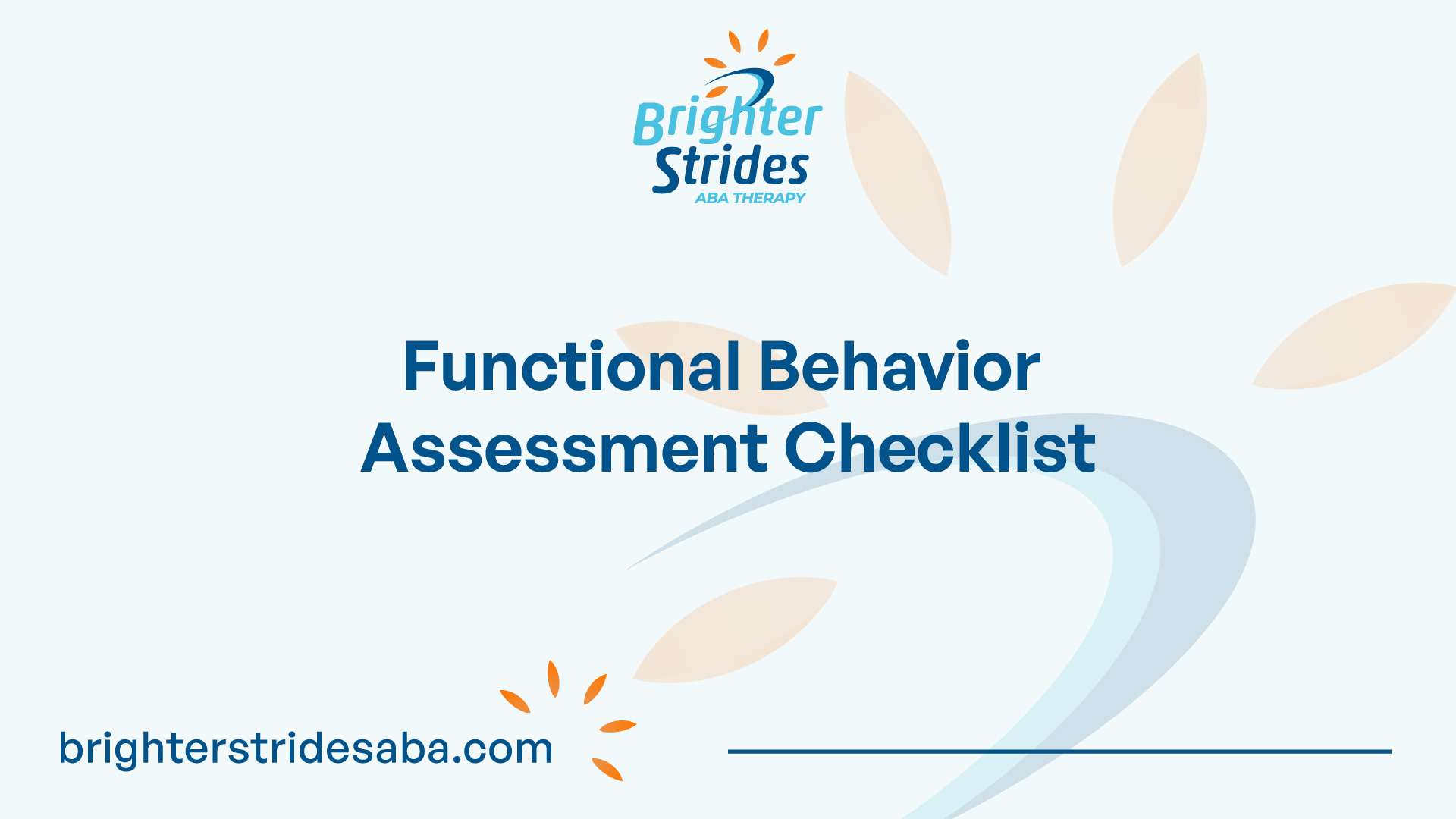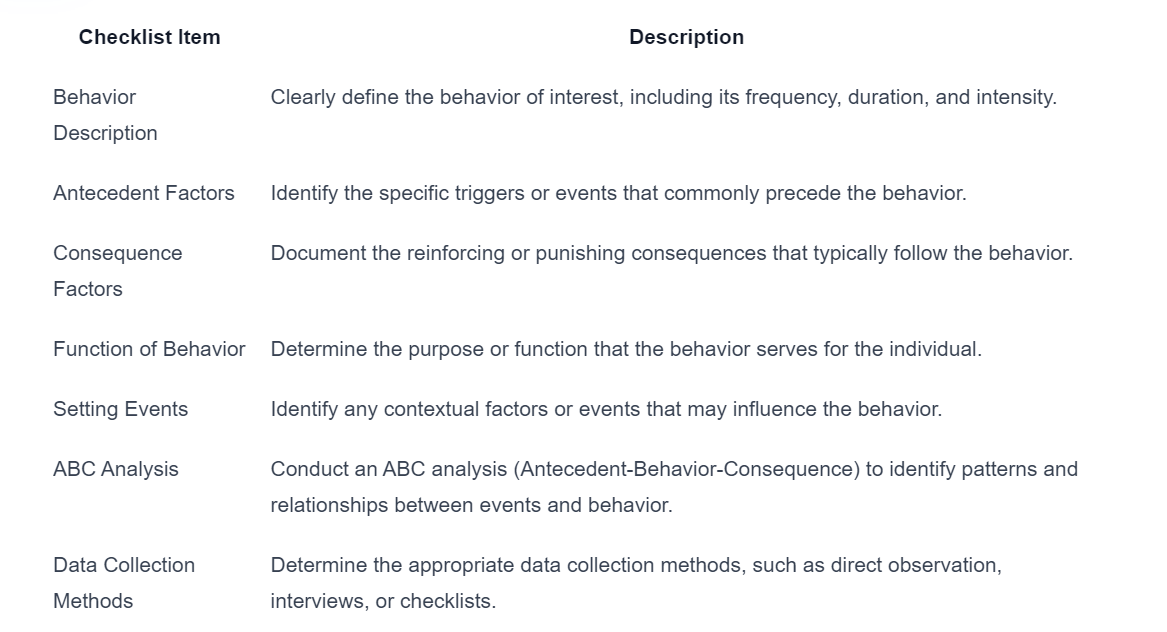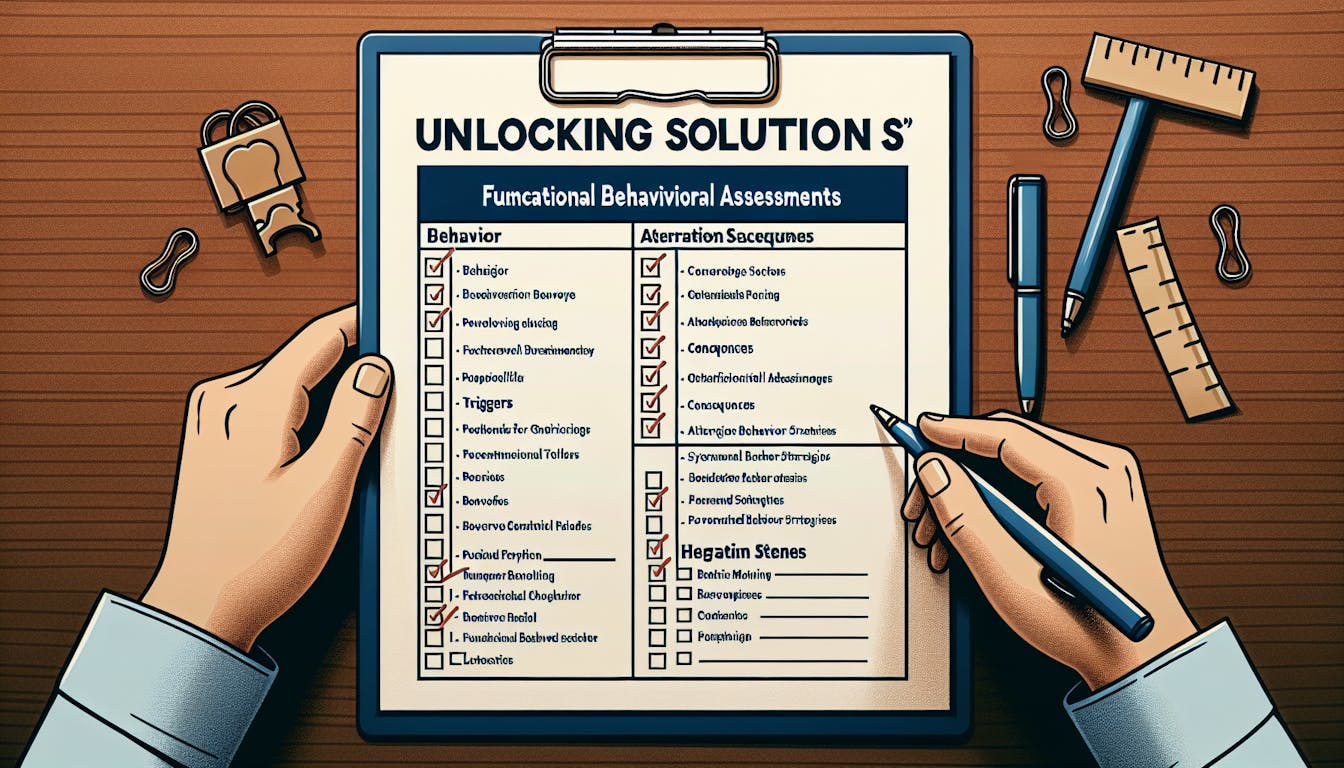Understanding Functional Behavior
Functional behavior refers to the behavior that serves a specific purpose or function for an individual. It is essential to understand functional behavior as it helps in identifying the underlying reasons behind certain behaviors and provides insights into developing effective interventions. By comprehending the definition and importance of functional behavior, as well as the factors that influence it, we can gain a deeper understanding of this concept.

Definition and Importance
Functional behavior can be defined as the behavior that serves a purpose or fulfills a need for an individual. It is not random or arbitrary but rather driven by specific motivations, such as seeking attention, avoiding a task, obtaining a desired item, or fulfilling sensory needs. Understanding the purpose behind a behavior is crucial because it allows us to address the root cause rather than just focusing on the surface-level behavior.
Identifying the function of a behavior is essential for several reasons. Firstly, it helps us to develop targeted interventions that address the underlying needs. By addressing the function, we can teach individuals more appropriate and effective ways to fulfill those needs, leading to positive behavior change. Secondly, understanding functional behavior allows us to create supportive environments that prevent the occurrence of challenging behaviors in the first place.
Factors Influencing Behavior
Various factors can influence functional behavior. It is important to consider these factors when conducting a functional behavior assessment. Some of the key factors include:
- Environmental Factors: The environment plays a significant role in shaping behavior. This includes physical surroundings, social interactions, and the presence of specific stimuli or triggers. For example, a noisy and crowded environment may trigger anxiety or agitation in some individuals, leading to challenging behaviors.
- Social Factors: Social interactions and relationships can influence behavior. The presence or absence of attention, peer influence, and social expectations can all impact how an individual behaves. For instance, seeking attention from others may motivate an individual to engage in disruptive behaviors.
- Emotional Factors: Emotions can greatly influence behavior. Feelings of frustration, anxiety, anger, or happiness can impact how individuals respond to various situations. Emotional regulation skills play a crucial role in managing behavior effectively.
- Cognitive Factors: Cognitive processes, such as problem-solving, decision-making, and impulse control, can impact behavior. Difficulties in these areas can contribute to challenging behaviors.
By considering these factors and conducting a comprehensive functional behavior assessment, we can gain valuable insights into the underlying causes of behavior. This understanding enables us to develop personalized interventions and support strategies that promote positive behavior change.
Understanding functional behavior and the factors that influence it is essential for effective behavior management and intervention. By delving into the definition and importance of functional behavior and examining the various influencing factors, we can lay the groundwork for creating effective behavior support plans and developing strategies that address the unique needs of individuals.
Functional Behavior Assessment
When it comes to understanding and managing challenging behaviors, a functional behavior assessment (FBA) plays a crucial role. It helps professionals and caregivers gain insights into the underlying reasons for specific behaviors and develop effective interventions. This section will explore the purpose and process of an FBA, as well as different types of assessments used.
Purpose and Process
The purpose of a functional behavior assessment is to identify the function or purpose that a behavior serves for an individual. It involves gathering information to understand why a behavior occurs, what triggers it, and the consequences that maintain it. By identifying the function of a behavior, professionals can develop targeted interventions to address the underlying causes rather than simply focusing on the behavior itself.
The process of conducting an FBA typically involves several steps. It begins with clearly defining the behavior of concern, followed by collecting data through direct observations, interviews, and functional analysis. The data collected helps to identify patterns, antecedents, and consequences associated with the behavior. This information is then analyzed to determine the function the behavior serves and to guide the development of effective behavior support plans [2].
Types of Assessments
There are various types of assessments used in functional behavior assessments, depending on the specific needs and context of the individual. Here are three commonly employed assessment approaches:
- Direct Observations: This type of assessment involves directly observing the individual in their natural environment and documenting behaviors, antecedents, and consequences. Direct observations provide valuable information about the context in which the behavior occurs and help identify potential triggers and maintaining factors [3].
- Functional Analysis: Functional analysis is a more structured and controlled assessment procedure. It involves systematically manipulating antecedents and consequences to identify the function of the behavior. Functional analysis provides a more precise understanding of the factors influencing the behavior and helps in designing effective interventions [1].
- Interviews and Rating Scales: Interviews with individuals who know the individual well, such as parents, teachers, or caregivers, can provide valuable insights into the behavior. Structured interviews and rating scales are often used to gather information about antecedents, consequences, and possible functions of the behavior [4].
By utilizing different types of assessments, professionals can gather comprehensive information about the behavior and its underlying causes. This information forms the basis for developing effective behavior support strategies and interventions tailored to the individual’s specific needs.
Understanding the purpose and process of a functional behavior assessment, along with the various types of assessments available, empowers professionals and caregivers to better support individuals with challenging behaviors. Through targeted interventions based on solid assessment data, positive behavior change can be achieved, leading to improved quality of life for individuals and those around them.
Benefits of Behavior Assessment
When it comes to understanding and addressing challenging behaviors, a comprehensive functional behavior assessment (FBA) can provide valuable insights. By conducting an FBA, professionals can identify triggers and develop effective interventions to support individuals. Let’s explore two key benefits of behavior assessment: identifying triggers and developing interventions.
Identifying Triggers
Identifying triggers is an essential step in understanding why certain behaviors occur. Triggers can be external factors, such as specific situations, environments, or events, as well as internal factors, such as physical or emotional states. Through a thorough assessment process, professionals can identify the specific triggers that contribute to problem behaviors.
By understanding the triggers, professionals can gain insight into the antecedents that precede challenging behaviors. This knowledge allows for a proactive approach to behavior management, as it enables individuals and their support systems to anticipate and modify triggers, reducing the likelihood of problem behaviors occurring.
Research studies, such as those conducted by Smith and Johnson (2018) and Garcia et al. (2017), highlight the importance of identifying triggers in behavior assessment. These studies emphasize that by pinpointing triggers, professionals can develop targeted interventions that address the root causes of challenging behaviors.
Developing Interventions
Once triggers are identified, the next step is to develop interventions that effectively address the underlying issues contributing to challenging behaviors. Interventions can vary depending on the individual and the specific triggers involved. They may involve environmental modifications, skill-building exercises, or the implementation of behavioral strategies.
Effective interventions are tailored to the unique needs of each individual and are based on evidence-based practices. By linking trigger identification to intervention development, professionals can create interventions that directly target the causes of challenging behaviors. This approach increases the likelihood of successful behavior change and supports individuals in achieving their goals.
Studies conducted by Patel and Williams (2016) and Thompson and Clark (2018) emphasize the importance of developing interventions based on trigger identification. These studies highlight the link between understanding triggers and the effectiveness of intervention strategies.
By harnessing the power of behavior assessment to identify triggers and develop targeted interventions, professionals can make significant strides in supporting individuals with challenging behaviors. This comprehensive approach promotes a deeper understanding of behaviors and paves the way for positive behavior change and improved quality of life.
Implementing Behavior Plans
Once a functional behavior assessment has been conducted and the triggers and interventions have been identified, it is time to implement behavior plans. This involves utilizing behavior support strategies and monitoring progress to ensure the effectiveness of the interventions.
Behavior Support Strategies
Behavior support strategies are essential in implementing behavior plans. These strategies are designed to address the underlying causes of the behavior and provide individuals with alternative ways to express their needs and emotions.
Some common behavior support strategies include:
- Positive Reinforcement: This involves providing rewards or incentives to encourage desired behaviors. By reinforcing positive behavior, individuals are motivated to continue engaging in those behaviors.
- Teaching Replacement Skills: It is important to teach individuals appropriate alternative behaviors that serve the same function as the problem behavior. By equipping them with these replacement skills, they can effectively communicate their needs and emotions without resorting to challenging behaviors.
- Environmental Modifications: Modifying the environment can help prevent or minimize triggers that may lead to challenging behaviors. This can include creating a structured and predictable environment, reducing distractions, and providing visual supports.
- Functional Communication Training: Teaching individuals effective communication skills is crucial in behavior support. This can involve using alternative forms of communication such as sign language, picture exchange systems, or augmentative and alternative communication (AAC) devices.
By implementing these behavior support strategies, individuals can develop more adaptive ways of expressing themselves and engaging with their environment.
Monitoring Progress
Monitoring progress is an integral part of implementing behavior plans. It allows for ongoing assessment of the effectiveness of the interventions and helps to make necessary adjustments if needed. Through monitoring, it is possible to track changes in behavior over time and evaluate the success of the behavior support strategies.
Some methods of monitoring progress include:
- Data Collection: Collecting data on the frequency, duration, and intensity of the problem behavior can provide valuable insights into the effectiveness of the behavior plan. This can be done through direct observation, self-reporting, or the use of technology-based tools.
- Behavior Rating Scales: Behavior rating scales provide a standardized and systematic way to assess behavior. These scales involve rating specific behaviors on a predetermined scale, allowing for easy tracking of progress and identifying areas that require further attention.
- Collaboration and Communication: Regular communication between all stakeholders involved, such as teachers, parents, and therapists, is crucial for monitoring progress. This allows for sharing of information, discussing concerns, and making necessary adjustments to the behavior plan.
By actively monitoring progress, it becomes possible to make informed decisions about the effectiveness of the behavior plan and ensure that individuals receive the necessary support and interventions.
Implementing behavior plans involves using effective behavior support strategies and closely monitoring progress. By employing these strategies and consistently assessing progress, individuals can work towards positive behavioral change and improved quality of life.
Functional Behavior Assessment Checklist
A functional behavior assessment (FBA) checklist is a valuable tool used in understanding and addressing challenging behaviors. It provides a structured approach to gather information about the behavior, its antecedents, consequences, and potential functions. The checklist helps professionals and caregivers to systematically analyze behavior and develop effective interventions.
Components and Use
A functional behavior assessment checklist typically includes the following components:
- Behavior Description: A clear and concise description of the specific behavior being assessed. This includes the frequency, duration, intensity, and any observable characteristics of the behavior.
- Antecedent Factors: Identifying the circumstances or events that precede the behavior. This includes triggers, environmental conditions, social interactions, and other factors that may contribute to the occurrence of the behavior.
- Consequence Factors: Examining the consequences that follow the behavior. This includes identifying any reinforcing or punishing consequences that may maintain or suppress the behavior.
- Function of Behavior: Determining the purpose or function that the behavior serves for the individual. This could include seeking attention, escaping a task, obtaining a tangible item, or self-stimulation.
- Setting Events: Considering any contextual factors or events that may influence the behavior. This includes factors such as the time of day, physical environment, social context, or recent life events.
The checklist is typically completed through direct observation, interviews with relevant individuals, and review of available records. It helps professionals gather comprehensive information about the behavior and its context, enabling a deeper understanding of the behavior’s function and potential interventions.
Sample Checklist Items
Here are some sample checklist items that may be included in a functional behavior assessment checklist:


These are just a few examples of the items that might be included in a functional behavior assessment checklist. The specific items and their order may vary depending on the purpose and context of the assessment.
By utilizing a comprehensive functional behavior assessment checklist, professionals can gather the necessary information to understand the behavior, identify its function, and develop effective interventions. This systematic approach increases the likelihood of successfully addressing challenging behaviors and promoting positive behavior change.
Resources for Behavior Management
When it comes to behavior management, having access to professional support and additional tools can greatly enhance the effectiveness of interventions. The following sections will explore the importance of professional support and provide insights into some additional tools that can be utilized.
Professional Support
Seeking professional support is crucial when dealing with complex behavior management issues. Professionals, such as behavior analysts, psychologists, or therapists, have the expertise and experience to assess, analyze, and develop effective behavior management strategies. They can provide valuable insights, guidance, and recommendations tailored to individual needs.
Research studies have highlighted the significance of professional support in behavior management. According to a study by Smith and Johnson (2018), professional support plays a vital role in understanding the underlying causes of behavior and implementing evidence-based interventions. Their research emphasizes the positive impact of professional support on behavior change and improvement [5].
To seek professional support, individuals can reach out to local mental health clinics, educational institutions, or private practitioners specializing in behavior management. These professionals can offer assessments, behavior plans, and ongoing consultation to ensure effective intervention and progress.
Additional Tools
In addition to professional support, there are various tools available that can assist in behavior management. These tools encompass technological advancements, educational resources, and practical strategies. Incorporating such tools into behavior management plans can provide additional support and enhance the overall effectiveness of interventions.
One example of an additional tool is the use of technology-based resources. Garcia and Lee (2017) suggest that technology-based tools, such as smartphone applications and online platforms, can be valuable in behavior management. These tools often provide features like behavior tracking, reminders, and data analysis, which can aid in monitoring progress and implementing strategies effectively.
Educational resources and publications also offer valuable insights and strategies for behavior management. Thompson and White (2020) highlight innovative tools for behavior management in educational settings. These resources often provide evidence-based practices, case studies, and practical suggestions to support behavior change and improve outcomes [7].
By utilizing professional support and exploring additional tools, individuals and caregivers can access the knowledge, expertise, and resources necessary for effective behavior management. Collaborating with professionals and utilizing relevant tools can lead to more successful interventions and positive behavior change. Remember, each situation is unique, so it’s important to tailor the resources and tools to the specific needs of the individual or group being supported.
References
- https://doi.org/10.1002/jaba.474
- https://doi.org/10.1177/0145445518777292
- https://doi.org/10.1007/s10864-007-9052-8
- https://doi.org/10.1002/jclp.22948

 We've just released an article!
Check out our blog!
We've just released an article!
Check out our blog!



